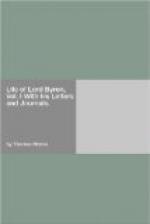As there is no record, however, as far as I can discover, of any of his ancestors having been engaged in the Holy Wars, it is possible that he may have had no other authority for this notion than the tradition which he found connected with certain strange groups of heads, which are represented on the old panel-work, in some of the chambers at Newstead. In one of these groups, consisting of three heads, strongly carved and projecting from the panel, the centre figure evidently represents a Saracen or Moor, with an European female on one side of him, and a Christian soldier on the other. In a second group, which is in one of the bed-rooms, the female occupies the centre, while on each side is the head of a Saracen, with the eyes fixed earnestly upon her. Of the exact meaning of these figures there is nothing certain known; but the tradition is, I understand, that they refer to some love-adventure, in which one of those crusaders, of whom the young poet speaks, was engaged.
Of the more certain, or, at least, better known exploits of the family, it is sufficient, perhaps, to say, that, at the siege of Calais under Edward III., and on the fields, memorable in their respective eras, of Cressy, Bosworth, and Marston Moor, the name of the Byrons reaped honours both of rank and fame, of which their young descendant has, in the verses just cited, shown himself proudly conscious.
It was in the reign of Henry VIII., on the dissolution of the monasteries, that, by a royal grant, the church and priory of Newstead, with the lands adjoining, were added to the other possessions of the Byron family.[7] The favourite upon whom these spoils of the ancient religion were conferred, was the grand-nephew of the gallant soldier who fought by the side of Richmond at Bosworth, and is distinguished from the other knights of the same Christian name in the family, by the title of “Sir John Byron the Little, with the great beard.” A portrait of this personage was one of the few family pictures with which the walls of the abbey, while in the possession of the noble poet, were decorated.
At the coronation of James I. we find another representative of the family selected as an object of royal favour,—the grandson of Sir John Byron the Little, being, on this occasion, made a knight of the Bath. There is a letter to this personage, preserved in Lodge’s Illustrations, from which it appears, that notwithstanding all these apparent indications of prosperity, the inroads of pecuniary embarrassment had already begun to be experienced by this ancient house. After counselling the new heir as to the best mode of getting free of his debts, “I do therefore advise you,” continues the writer,[8] “that so soon as you have, in such sort as shall be fit, finished your father’s funerals, to dispose and disperse that great household, reducing them to the number of forty or fifty, at the most, of all sorts; and, in my opinion, it will be far better for you to live for a time in Lancashire rather than in Notts, for many good reasons that I can tell you when we meet, fitter for words than writing.”




